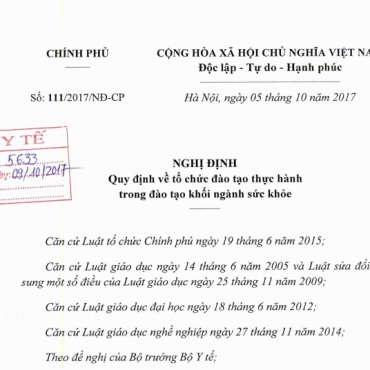Liên hệ tuyển sinh
Hợp tác Quốc tế
SARS-CoV-2 Viral Variants—Tackling a Moving Target
SARS-CoV-2 Viral Variants—Tackling a Moving Target
John R. Mascola, MD1; Barney S. Graham, MD, PhD1; Anthony S. Fauci, MD2
JAMA. 2021;325(13):1261-1262. doi:10.1001/jama.2021.2088
Coronavirus Variants and Vaccines
In this issue of JAMA, Zhang and colleagues1 report the emergence of a novel severe acute respiratory syndrome coronavirus 2 (SARS-CoV-2) variant in Southern California that accounted for 44% (37 of 85) of samples collected and studied in January 2021. The terminology of viral variation can be confusing because the media and even scientific communications often use the terms variant, strain, and lineage interchangeably. The terminology reflects the basic replication biology of RNA viruses that results in the introduction of mutations throughout the viral genome. When specific mutations, or sets of mutations, are selected through numerous rounds of viral replication, a new variant can emerge. If the sequence variation produces a virus with distinctly different phenotypic characteristics, the variant is co-termed a strain. When through genetic sequencing and phylogenetic analysis a new variant is detected as a distinct branch on a phylogenetic tree, a new lineage is born.
New variants become predominant through a process of evolutionary selection that is not well understood. Once identified, several questions arise regarding the potential clinical consequences of a new variant: Is it more readily transmitted; is it more virulent or pathogenic; and can it evade immunity induced by vaccination or prior infection? For these reasons, new viral variants are studied, leading to the terms variant under investigation or variant of concern.
To communicate effectively about new SARS-CoV-2 variants, a common nomenclature is needed, which like the virus, is evolving. Fortunately, the World Health Organization (WHO) is working on a systematic nomenclature that does not require a geographic reference, since viral variants can spread rapidly and globally. Currently, the terminology is overlapping, as reflected in the report by Zhang et al.1 This new variant (CAL.20C) is termed lineage 20C/S:452R in Nextstrain nomenclature,2 referring to the parent clade 20C and spike alteration 452R. Similarly, using a distinct PANGO nomenclature,3 this variant derives from lineage B (B.1.429 and B.1.427). While alterations in any viral genes can have implications for pathogenesis, those arising in the spike protein that mediates viral entry into host cells and is a key target of vaccines and monoclonal antibodies are of particular interest. The new variant, identified in California and termed 20C/S:452R, has 3 amino acid changes in the spike protein, represented using the single-letter amino acid nomenclature: S13I, W152C, and L452R. To interpret this new set of alterations, it is useful to review what is known about recent variants that have become predominant in other regions of the world.
During the early phase of the SARS-CoV-2 pandemic, there were only modest levels of genetic evolution; however, more recent information indicates that even a single amino acid substitution can have biological implications. Starting in April 2020, the original SARS-CoV-2 strain was replaced in many regions of the world by a variant called D614G, which was subsequently shown to increase the efficiency of viral replication in humans and was more transmissible in animal models.4-6 The D614G strain appears to position its receptor binding domain to interact more efficiently with the ACE2 receptor, and it is associated with higher nasopharyngeal viral RNA loads, which may explain its rise to dominance.
In October 2020, sequencing analysis in the UK detected an emerging variant, later termed B.1.1.7 or 20I/501Y.V1, which is now present and rapidly spreading in many countries.7 B.1.1.7 contains 8 mutations in the spike protein and maintains the D614G mutation. One of these, N501Y, appears to further increase the spike protein interaction with the ACE2 receptor. Epidemiological studies indicate that the B.1.1.7/20I/501Y.V1 strain is 30% to 80% more effectively transmitted and results in higher nasopharyngeal viral loads than the wild-type strain of SARS-CoV. Also of concern are retrospective observational studies suggesting an approximately 30% increased risk of death associated with this variant.8
Another notable variant, 20H/501Y.V2 or B.1.351, was first identified is South Africa, where it has rapidly become the predominant strain.9 Cases attributed to this strain have been detected in multiple countries outside of South Africa, including recent cases in the US. B.1.351 shares the D614G and N501Y mutations with B.1.1.1.7; thus, it is thought to also have a high potential for transmission. There are no data yet to suggest an increased risk of death due to this variant. Importantly, this constellation of mutations—9 total in the spike protein—add yet another dimension of concern. B.1.351 strains are less effectively neutralized by convalescent plasma from patients with coronavirus disease 2019 (COVID-19) and by sera from those vaccinated with several vaccines in development.10-12 The decrement in neutralization can be more than 10-fold with convalescent plasma and averages 5- to 6-fold less with sera from vaccinated individuals. Fortunately, neutralization titers induced by vaccination are high, and even with a 6-fold decrease, serum can still effectively neutralize the virus.
Nonetheless, these data are concerning because they indicate that viral variation can result in antigenic changes that alter antibody-mediated immunity. This is highlighted by in vitro studies showing the B.1.351 strain to be partially or fully resistant to neutralization by certain monoclonal antibodies, including some authorized for therapeutic use in the US.12 The prevalent strains in the US appear to remain sensitive to therapeutic monoclonal antibodies; however, recent evolutionary history raises the concern that the virus could be only a few mutations away from more substantive resistance.
COVID-19 vaccine development has been an extraordinary success; however, it is unclear how effective these vaccines will be against the new variants. The interim data from 2 randomized placebo-controlled vaccine studies, the rAd26 from Janssen and a recombinant protein from Novavax, offer some insight. The Janssen study included sites in the US, Brazil, and South Africa with efficacy against COVID-19 at 72%, 66%, and 57%, respectively.13 Novavax reported efficacy from studies in the UK and South Africa with overall efficacy of 89% and 60%, respectively.14 Viral sequence data from infected patients showed that the B.1.351 strain was responsible for the majority of infections in South Africa. Lower vaccine efficacy in the South Africa cohort could be related to antigenic variation or to geographic or population differences. Despite the reduced efficacy, the rAd26 vaccine was 85% effective overall in preventing severe COVID-19, and protection was similar in all regions.
These data suggest that current vaccines could retain the ability to prevent hospitalizations and deaths, even in the face of decreased overall efficacy due to antigenic variation. It is unclear whether changes in vaccine composition will be needed to effectively control the COVID-19 pandemic; however, it is prudent to be prepared. Some companies have indicated plans to manufacture and test vaccines based on emerging variants, and such studies will provide important information on the potential to broaden the immune response.
The recognition of a novel emergent variant, 20C/S:452R, in the most populous US state necessitates further investigation for implications of enhanced transmission. In particular, the L452R mutation in the spike protein could affect the binding of certain therapeutic monoclonal antibodies. The emergence of this and other new variants is likely to be a common occurrence until the spread of this virus is reduced. This emphasizes the importance of a global approach to surveillance, tracking, and vaccine deployment. The approach should be systematic and include in vitro assessment of sensitivity to neutralization by monoclonal antibodies and vaccinee sera, vaccine protection of animals against challenge with new strains, and field data defining viral sequences from breakthrough infections in vaccinees. The infrastructure and process used for tracking and updating influenza vaccines could be used to inform that process. Finally, SARS-CoV-2 will be with the global population for some time and has clearly shown its tendency toward rapid antigenic variation, providing a “wake-up call” that a sustained effort to develop a pan-SARS-CoV-2 vaccine is warranted.
Article Information
Corresponding Author: John R. Mascola, MD, Vaccine Research Center, National Institute of Allergy and Infectious Diseases, National Institutes of Health, 40 Convent Dr, Bethesda, MD 20853 (jmascola@mail.nih.gov).
Published Online: February 11, 2021. doi:10.1001/jama.2021.2088
Conflict of Interest Disclosures: Dr Graham reports a patent for design of spike antigens with stabilizing mutations with multiple nonexclusive licenses for use in candidate vaccines. No other disclosures were reported.
References
1.Zhang W, Davis BD, Chen SS, et al. Emergence of a novel SARS-CoV-2 strain in Southern California. JAMA. Published online February 11, 2021. doi:10.1001/jama.2021.1612
ArticleGoogle Scholar
2.Nextstrain. Accessed February 8, 2021. https://nextstrain.org/
3.PANGO lineages. Accessed February 8, 2021. https://cov-lineages.org
4.Korber B, Fischer WM, Gnanakaran S, et al; Sheffield COVID-19 Genomics Group. Tracking changes in SARS-CoV-2 spike: evidence that D614G increases infectivity of the COVID-19 virus. Cell. 2020;182(4):812-827.e19. doi:10.1016/j.cell.2020.06.043PubMedGoogle ScholarCrossref
5.Yurkovetskiy L, Wang X, Pascal KE, et al. Structural and functional analysis of the D614G SARS-CoV-2 spike protein variant. Cell. 2020;183(3):739-751.e8. doi:10.1016/j.cell.2020.09.032PubMedGoogle ScholarCrossref
6.Hou YJ, Chiba S, Halfmann P, et al. SARS-CoV-2 D614G variant exhibits efficient replication ex vivo and transmission in vivo. Science. 2020;370(6523):1464-1468. doi:10.1126/science.abe8499PubMedGoogle Scholar
7.Rambaut A, Loman N, Pybus O, et al; COVID-19 Genomics Consortium UK. Preliminary genomic characterisation of an emergent SARS-CoV-2 lineage in the UK defined by a novel set of spike mutations. Virological.org. Posted December 18, 2020. Accessed January 3, 2021. https://virological.org/t/preliminary-genomic-characterisation-of-anemergent-sars-cov-2-lineage-in-the-uk-definedby-a-novel-set-of-spike-mutations/563
8.Horby P, Huntley C, Davies N, et al. Paper from the New and Emerging Respiratory Virus Threats Advisory Group (NERVTAG) on new coronavirus (COVID-19) variant B.1.1.7. Posted January 21, 2021. Accessed February 8, 2021. https://assets.publishing.service.gov.uk/government/uploads/system/uploads/attachment_data/file/955239/NERVTAG_paper_on_variant_of_concern__VOC__B.1.1.7.pdf
9.Tegally H, Wilkinson E, Giovanetti M, et al. Emergence and rapid spread of a new severe acute respiratory syndrome-related coronavirus 2 (SARS-CoV-2) lineage with multiple spike mutations in South Africa. medRxiv. Preprint published online December 22, 2020. doi:10.1101/2020.12.21.20248640Google Scholar
10.Wibmer CK, Ayres F, Hermanus T, et al. SARS-CoV-2 501Y.V2 escapes neutralization by South African COVID-19 donor plasma. bioRxiv. Preprint published online January 19, 2021. doi:10.1101/2021.01.18.427166Google Scholar
11.Wu K, Werner AP, Moliva JI, et al. mRNA-1273 vaccine induces neutralizing antibodies against spike mutants from global SARS-CoV-2 variants. bioRxiv. Preprint published online January 25, 2021. doi:10.1101/2021.01.25.427948Google Scholar
12.Ho D, Wang P, Liu L, et al. Increased resistance of SARS-CoV-2 variants B.1.351 and B.1.1.7 to antibody neutralization. Res Sq. Preprint published online January 29, 2021. doi:10.21203/rs.3.rs-155394/v1Google Scholar
13.Johnson & Johnson announces single-shot Janssen COVID-19 vaccine candidate met primary endpoints in interim analysis of its phase 3 ENSEMBLE trial. Johnson & Johnson. Posted January 29, 2021. Accessed February 8, 2021. https://www.jnj.com/johnson-johnson-announces-single-shot-janssen-covid-19-vaccine-candidate-met-primary-endpoints-in-interim-analysis-of-its-phase-3-ensemble-trial
14.Novavax COVID-19 vaccine demonstrates 89.3% efficacy in UK phase 3 trial. Novavax. Posted January 28, 2021. Accessed February 8, 2021. https://ir.novavax.com/news-releases/news-release-details/novavax-covid-19-vaccine-demonstrates-893-efficacy-uk-phase-3
Source: https://jamanetwork.com/journals/jama/fullarticle/2776542?guestAccessKey=8f7212ef-d1d1-49ef-b35f-809470630ef1&utm_source=silverchair&utm_medium=email&utm_campaign=article_alert-jama&utm_content=etoc&utm_term=040621
Các tin khác
- One in 10 People Who Had Omicron Got Long COVID: Study ( 20:25 - 01/06/2023 )
- Physical Medicine Academy Issues Guidance on Long COVID Neurologic Symptoms ( 09:58 - 19/05/2023 )
- SARS-CoV-2 đi qua nhau thai và lây nhiễm não của hai trẻ sơ sinh: “Đây là trường hợp đầu tiên” ( 16:55 - 10/04/2023 )
- Breakthrough' Study: Diabetes Drug Helps Prevent Long COVID ( 08:55 - 15/03/2023 )
- BCG vaccine (thuốc chủng ngừa bệnh lao) & SARS-CoV 2 (covid-19) infection ( 10:08 - 27/10/2022 )
- Đại dịch COVID-19 đã kết thúc? ( 09:11 - 22/09/2022 )
- Dị hình giới tính ở COVID-19: Ý nghĩa tiềm năng về lâm sàng và sức khỏe cộng đồng ( 09:22 - 19/03/2022 )
- COVID-19 Update ( 21:00 - 06/03/2022 )
- Một người có thể tái mắc Covid-19 bao nhiêu lần ?? ( 20:25 - 06/03/2022 )
- T-cells from common colds can provide protection against COVID-19 - study ( 08:25 - 11/01/2022 )














